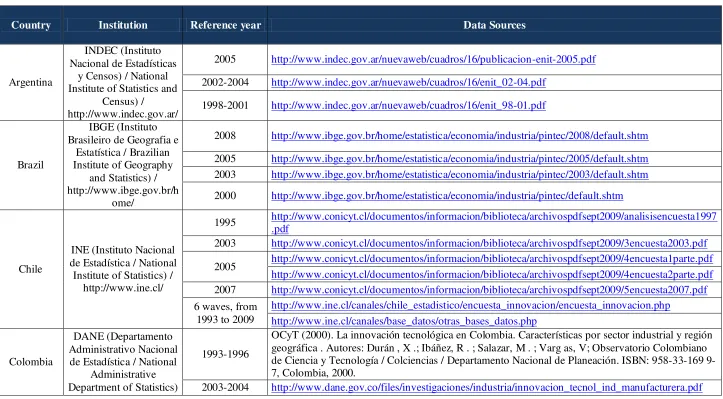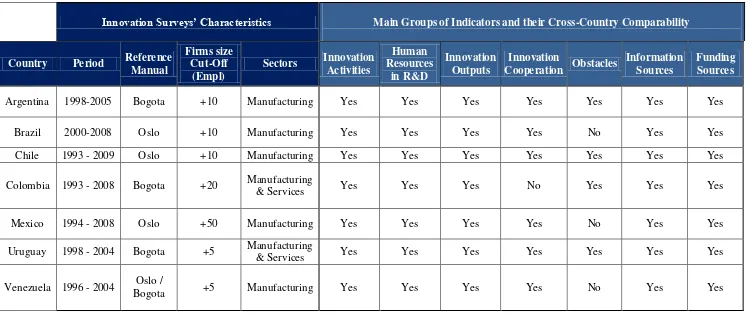Munich Personal RePEc Archive
Innovation surveys in Latin America: a
primer
Castellacci, Fulvio and Natera, Jose Miguel
2012
Online at
https://mpra.ub.uni-muenchen.de/37769/
1
Innovation Surveys in Latin America:
A Primer
Fulvio Castellacci
*and Jose Miguel Natera
†*
Norwegian Institute of International Affairs (NUPI), Oslo, Norway. E-mail: fc@nupi.no
†
GRINEI – ICEI, University Complutense, Madrid, Spain. E-mail: jm.natera@pdi.ucm.es
This version: January 14
th, 2012
Innovation Surveys in Latin American started more than ten years ago. Initially based
on the Oslo Manual, adapted to better suit the characteristics of innovation and
technology diffusion in Latin American countries, the Bogota Manual (RICyT, 2001)
did later formulate a set of methodological guidelines that were followed by many of
the countries in the region (Sutz, 2000). As of today, 15 Latin American countries have
carried out a total of 46 innovation surveys, and Latin America does now stand out as
the region with the most active innovation survey data production within the developing
world (Marins, 2011). This short article provides a primer to innovation surveys in Latin
America, listing the available data, some key institutional and scholarly references
available on the web, and briefly pointing to some methodological issues and challenges
for future improvements.
Table 1 presents a summary of the innovation surveys carried out in ten Latin American
countries for which data and/or key institutional references are available on the
Internet.1 Innovation survey data is mostly produced and provided by the national
institutes that deal with statistics information management in each respective country.
However, the information is not in all cases easily available and ready to use, and it is
presented in a high range of different formats and, in most cases, in Spanish or
Portuguese language only. In order to ensure a wider dissemination and use of this type
1
2
of data by the international research and policy community in the future, it would be of
great benefit to achieve a higher coordination among the various national institutes and
a better harmonization of the presentation format of the various survey data and results.
The Network on Science and Technology Indicators – Ibero-American and
Inter-American (RICyT) is a key institutional reference in the field.2 During the last sixteen
years, it has made a great contribution to overcome this issue by gathering most of the
available data and increasing the methodological standardization across countries in the
region.
< Insert Table 1 here >
A higher degree of harmonization would in particular be beneficial to the Latin
American and international research community, since it would make it possible to
carry out cross-country and cross-industry empirical analyses on a much more
systematic basis than it has been the case so far. Raffo et al. (2008) present one of the
few comparative exercises that have been produced using Latin American innovation
survey data. Anlló, Suárez and De Angelis (2009), Crespi and Peirano (2007) and Sutz
(2000) carry out a thorough comparison and methodological discussion of Latin
American innovation surveys, pointing out the data and results that can be safely used
for international comparison and those that are less reliable and should be threatened
with care. Table 2 presents a summary of the key issues highlighted in these papers. A
look at the various survey questionnaires shows that some degree of comparability
across countries is indeed present. In order to further increase this, the European
experience with the Community Innovation Surveys (CIS) is relevant, particularly with
reference to the standardization and micro-data data collection efforts made by Eurostat,
OECD and some EU-funded projects in the last few years.
A second issue that hampers a wider use, dissemination and impact of Latin American
innovation survey data across the international research community is its still limited
application to economic and econometric analyses of micro-level innovation patterns
and impacts within each national economy. The challenge is twofold. On the one hand,
it is important to ensure that researchers in the various countries in the region can more
easily get access to firm-level innovation data and link them to other micro-level
2
3
sources of information on, e.g., firms’ productivity, profitability, employment and export activities. On the other hand, it is crucial that this type of linked
innovation-economic data will increasingly be available not only for one specific point in time, but
rather for different years (Chudnovsky et al., 2006; De Negri et al., 2007).
These two aspects – matching innovation and economic indicators, and working with
panel data rather than cross-sections – represent important challenges for ensuring a
greater reliability and diffusion of Latin American empirical studies of innovation
across the international research community (Anlló, Suárez and De Angelis, 2009;
Crespi and Peirano, 2007; Sutz, 2000). The European experience with CIS-based
econometric analyses indicates that only a thorough dealing with these two issues gives
firm-level empirical analyses the necessary credibility and thoroughness to get accepted
and have wide impact on the global community of innovation scholars (Mairesse and
Mohnen, 2010).
< Insert Table 2 here >
Acknowledgments
We are grateful for the useful suggestions received from Diana Suárez, Flavio Peixoto,
Jocelyn Olivary, Judith Sutz and Mauricio Uriona. The usual disclaimers apply.
References
Anlló, G., Suárez, D. and De Angelis J., 2009. “Indicadores de Innovación en América
Latina: diez años del Manual de Bogotá”. RICyT:
http://innovacion.ricyt.org/files/3_3Innovacion.pdf
Chudnovsky, D., López, A. and Pupato, G., 2006. Innovation and productivity in developing countries: A study of Argentine manufacturing firms' behavior (1992-2001). Research Policy, 35(2), pp. 266-288.
Crespi, G. and Pirano,F., 2007. “Measuring Innovation in Latin America: what we did, where we are and what we want to do”presentation at the Conference on Micro Evidence on Innovation in Developing Countries, UNU-MERIT. Maastricht.
4
Mairesse, J. and Mohnen, P., 2010. “Using innovations surveys for econometric analysis”. UNU-MERIT Working Paper Series. Available at:
http://www.merit.unu.edu/publications/wppdf/2010/wp2010-023.pdf
Marins, L., 2011. “Innovation Surveys in developing countries: an overview”
presentation at the 9th Globelics Conference 2011. Buenos Aires.
Raffo, J., L’huillery, S. and Miotti, L., 2008. “Northern and Southern Innovativity: a Comparison across European and Latin American Countries”, European Journal of Development Research, 20(2), 219-239.
RICyT, 2001. “Manual de Bogotá: Normalización de Indicadores de Innovación
Tecnológica en América Latina y el Caribe”. Bogotá.
http://www.ricyt.org/interior/difusion/pubs/bogota/bogota.pdf
Sutz, J. 2000. “Las encuestas de innovación latinoamericanas: un análisis comparativo de las formas de indagación”. Organización de Estados Americanos (OEA).
5
Table 1. Innovation Surveys in Latin America: Institutions and Data Sources
Country Institution Reference year Data Sources
Argentina
INDEC (Instituto Nacional de Estadísticas
y Censos) / National Institute of Statistics and
Census) /
http://www.indec.gov.ar/
2005 http://www.indec.gov.ar/nuevaweb/cuadros/16/publicacion-enit-2005.pdf
2002-2004 http://www.indec.gov.ar/nuevaweb/cuadros/16/enit_02-04.pdf
1998-2001 http://www.indec.gov.ar/nuevaweb/cuadros/16/enit_98-01.pdf
Brazil
IBGE (Instituto Brasileiro de Geografia e
Estatística / Brazilian Institute of Geography
and Statistics) / http://www.ibge.gov.br/h
ome/
2008 http://www.ibge.gov.br/home/estatistica/economia/industria/pintec/2008/default.shtm
2005 http://www.ibge.gov.br/home/estatistica/economia/industria/pintec/2005/default.shtm
2003 http://www.ibge.gov.br/home/estatistica/economia/industria/pintec/2003/default.shtm
2000 http://www.ibge.gov.br/home/estatistica/economia/industria/pintec/default.shtm
Chile
INE (Instituto Nacional de Estadística / National
Institute of Statistics) / http://www.ine.cl/
1995 http://www.conicyt.cl/documentos/informacion/biblioteca/archivospdfsept2009/analisisencuesta1997
2003 http://www.conicyt.cl/documentos/informacion/biblioteca/archivospdfsept2009/3encuesta2003.pdf
2005 http://www.conicyt.cl/documentos/informacion/biblioteca/archivospdfsept2009/4encuesta1parte.pdf
http://www.conicyt.cl/documentos/informacion/biblioteca/archivospdfsept2009/4encuesta2parte.pdf
2007 http://www.conicyt.cl/documentos/informacion/biblioteca/archivospdfsept2009/5encuesta2007.pdf
6 waves, from 1993 to 2009
http://www.ine.cl/canales/chile_estadistico/encuesta_innovacion/encuesta_innovacion.php http://www.ine.cl/canales/base_datos/otras_bases_datos.php
Colombia
DANE (Departamento Administrativo Nacional de Estadística / National
Administrative Department of Statistics)
1993-1996
OCyT (2000). La innovación tecnológica en Colombia. Características por sector industrial y región geográfica . Autores: Durán , X .; Ibáñez, R . ; Salazar, M . ; Varg as, V; Observatorio Colombiano de Ciencia y Tecnología / Colciencias / Departamento Nacional de Planeación. ISBN: 958-33-169 9-7, Colombia, 2000.
6
/ http://www.dane.gov.co 3 waves, from
2004 to 2008 http://www.dane.gov.co/index.php?option=com_content&view=article&id=104&Itemid=61
Costa Rica
MICIT (Ministerio de Ciencia y Tecnología / Ministry of Science and
Technology) / http://www.micit.go.cr/
3 waves, from
2006 to 2009 http://www.micit.go.cr/index.php/docman/cat_view/28-indicadores/29-indicadores-nacionales.html
Mexico
INEGI (Instituto Nacional de Estadística y
Geografía / National Institute of Statistics and
Geography) / http://www.inegi.org.mx
1994-1996
CINCyT(1998).Informe de la Encuesta Nacional sobre Innovación en el Sector Manufacturero1997. Consejo Nacional de Ciencia y Tecnología, Dirección Adjunta de Política Científica y Tecnológica. México 1998. 1999-2000 http://www.siicyt.gob.mx/siicyt/docs/Estadisticas3/ENCUESTAS/ENCUESTA%20INNOVACION/ parte1.Pdf http://www.siicyt.gob.mx/siicyt/docs/Estadisticas3/ENCUESTAS/ENCUESTA%20INNOVACION/ parte2.Pdf
2004 http://www.inegi.org.mx/Sistemas/temasV2/Default.aspx?s=est&c=19007
2006 http://www.siicyt.gob.mx/siicyt/docs/Estadisticas3/Informe2007/Innovacion.pdf
2008 http://innovacion.ricyt.org/files/indicadores_cti_2008.rar
Panama
SENACYT (Secretaría Nacional de Ciencia y
Tecnología / National Secretary of Science and
Technology) / http://www.senacyt.gob.
pa
2009 http://www.senacyt.gob.pa/transparencia/descargas/103/2009_eidi.pdf
Peru
CONCYTEC (Consejo Nacional de Ciencia, Tecnología e Innovación
Tecnológica / National Council of Science,
Technology and Technological
Innovation) /
1999 http://innovacion.ricyt.org/files/indica_99_10.pdf
2004
http://portal.concytec.gob.pe/images/upload2010/indicadores_encyt2004/2_informe_1_empresas_en cyt2004.pdf
7
http://portal.concytec.go b.pe
Uruguay
ANII (Agencia Nacional de Investigación e Innovación / National Agency of Research and
Innovation) / http://www.anii.org.uy
1998-2000 http://www.anii.org.uy/imagenes/el_proceso_innovacion_industria_uruguaya3.pdf
2001-2003 http://www.anii.org.uy/imagenes/innovacion_industria_uruguaya_2001-2003_version_completa.pdf
2004
http://www.anii.org.uy/web/static/pdf/Encuesta_Innov_Indust.pdf
http://www.anii.org.uy/web/static/pdf/Encuesta_Innov_Indust.pdf
Venezuela
ONCTI (Observatorio Nacional de Ciencia, Tecnología e Innovación
/ National Observatory of Science, Technology
and Innovation) / http://oncti.gob.ve
1996
Testa, Pablo "Una aproximación estadística a las capacidades tecnológicas e innovadoras en la industria manufacturera Venezolana". En Pirela, Arnoldo (editor) Venezuela: el desafío de innovar. Caracas: Fundación Polar CENDES, 2003.
2004
Testa, Pablo, “Encuesta de capacidades tecnológicas e innovadoras en la industria venezolana: construcción de una taxonomía estadística”, ponencia presentada en el XII seminario
8
Table 2. Characteristics and Cross-country Comparability of Some of the Main Latin American Innovation Surveys
Innovation Surveys’ Characteristics Main Groups of Indicators and their Cross-Country Comparability
Country Period Reference
Manual
Firms size Cut-Off
(Empl)
Sectors Innovation
Activities
Human Resources
in R&D
Innovation Outputs
Innovation
Cooperation Obstacles
Information Sources
Funding Sources
Argentina 1998-2005 Bogota +10 Manufacturing Yes Yes Yes Yes Yes Yes Yes
Brazil 2000-2008 Oslo +10 Manufacturing Yes Yes Yes Yes No Yes Yes
Chile 1993 - 2009 Oslo +10 Manufacturing Yes Yes Yes Yes Yes Yes Yes
Colombia 1993 - 2008 Bogota +20 Manufacturing
& Services Yes Yes Yes No Yes Yes Yes
Mexico 1994 - 2008 Oslo +50 Manufacturing Yes Yes Yes Yes No Yes Yes
Uruguay 1998 - 2004 Bogota +5 Manufacturing
& Services Yes Yes Yes Yes Yes Yes Yes
Venezuela 1996 - 2004 Oslo /
Bogota +5 Manufacturing Yes Yes Yes Yes No Yes Yes

